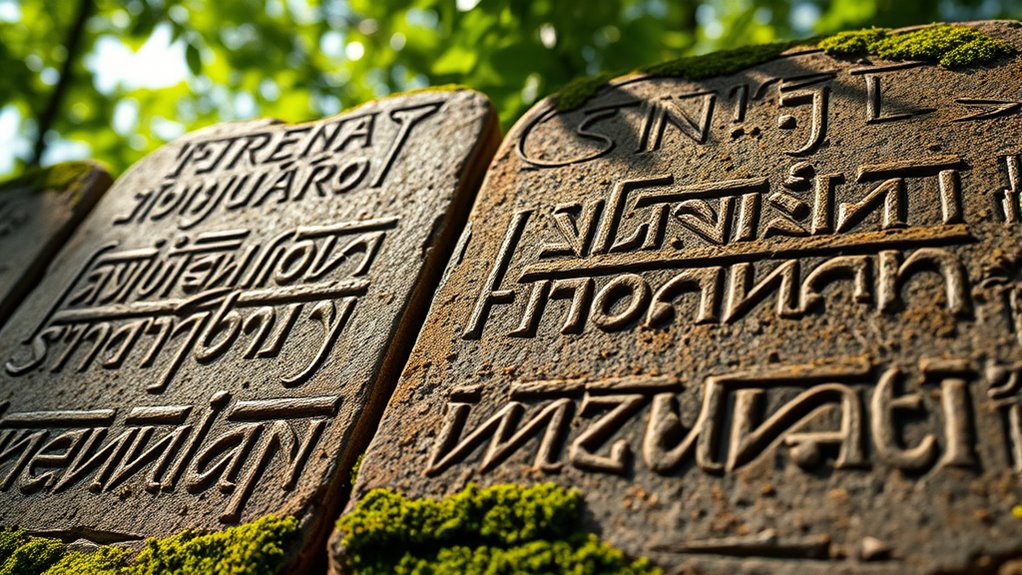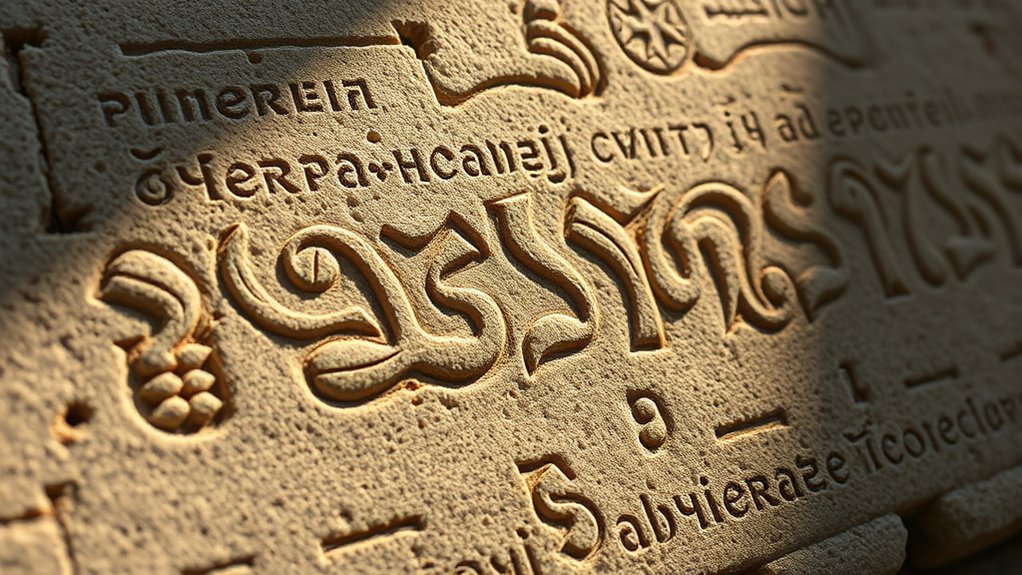Armenian names often reflect deep cultural roots, with meanings tied to history, religion, and nature. Suffixes like -ian, -yan, and -tsi reveal family, regional, and gender identities, showing who you belong to and your heritage. Traditional roots emphasize qualities like strength or spirituality, while modern influences mix tradition with new trends. By exploring these patterns further, you’ll uncover more about Armenia’s rich naming traditions and their significance.
Key Takeaways
- Armenian names often derive from ancient roots reflecting qualities like strength, wisdom, or spirituality.
- Suffixes such as -ian and -yan indicate familial or regional origins and gender, signifying lineage and identity.
- Female names typically feature suffixes that evoke grace and nurturing, while male names emphasize strength and leadership.
- Regional and dialectal variations influence the pronunciation and spelling of Armenian names across different areas.
- Names are deeply tied to cultural, religious, and historical traditions, often used in rituals and naming ceremonies.
Common Armenian Name Roots and Their Significance

Many Armenian names have roots that trace back to ancient language and cultural traditions, reflecting the values and history of the Armenian people. These Armenian name roots are often linked to significant historical figures, natural elements, or divine qualities, giving each name deep family significance. You’ll find that ancient civilizations, like the Urartians and Persians, heavily influenced the origins of many names, adding layers of meaning that connect individuals to their heritage. For instance, some roots emphasize strength, wisdom, or spirituality, shaping family identities over generations. Understanding these roots helps you appreciate how Armenian names carry more than just sounds—they embody a legacy that links you to your ancestors and the rich history of Armenia itself. Additionally, exploring the cultural influences behind these roots can provide further insight into the enduring significance of Armenian naming traditions.
Popular Suffixes and Their Meanings in Armenian Names

You’ll notice that Armenian names often feature specific suffixes with meaningful origins. These suffixes can indicate gender, cultural background, or historical significance. Understanding them helps you appreciate the rich layers behind Armenian naming traditions. Additionally, some suffixes may carry figurative connotations that reflect societal values or historical narratives.
Common Suffixes and Origins
Armenian names often feature distinctive suffixes that reveal their origins and meanings. These suffixes reflect Armenian naming customs and show how modern influences have shaped names today. For example, suffixes like -ian, -yan, and -tsi are common and indicate familial or regional roots. Here’s a quick look:
| Suffix | Meaning/Origin | Example Name |
|---|---|---|
| -ian/-yan | Son of or belonging to | Sarkisian |
| -ts | Diminutive or affectionate | Artashes |
| -ik | Small or endearing | Vahik |
| -ar | Land or place | Hayk’ar |
| -el | God or divine | Aregel |
Recognizing these suffixes helps you understand Armenian names’ rich history and how modern influences continue to evolve their meanings.
Gender Significance of Suffixes
Suffixes in Armenian names often carry gender significance, revealing whether a name is typically associated with males or females. This influences gender identity implications and shapes social perceptions. Recognizing these suffixes helps you understand cultural expectations and gender roles. Consider these key points:
- Certain suffixes signal masculinity, enhancing perceived strength and leadership qualities.
- Feminine suffixes often evoke grace, nurturing traits, and social acceptance.
- Deviating from typical suffix patterns can challenge gender norms and provoke reactions.
- These suffixes influence how others interpret your gender identity and societal role.
- Understanding gender-related suffixes can also shed light on historical naming conventions and societal values.
Cultural and Historical Context
Many popular Armenian name suffixes have deep roots in the country’s cultural and historical traditions, reflecting centuries of social values and linguistic evolution. Historical influences, such as Persia, Byzantium, and Ottoman rule, shaped Armenian naming customs, leading to the adoption of specific suffixes that convey social status, heritage, and identity. These suffixes often carry cultural significance, especially in family and clan names, emphasizing lineage and community ties. For example, suffixes like -ian and -yan highlight belonging to a family or tribe, reinforcing historical bonds. Understanding these suffixes offers insight into Armenia’s rich history and social structure, helping you appreciate how ancestral values continue to influence naming practices today. Additionally, the choice of suffixes can indicate regional origins or social distinctions within Armenian society.
The Role of Religious and Historical Influences in Naming

Your name often reflects religious beliefs and historical events that shape Armenian culture. Sacred names and traditions honor spiritual values, while historical figures inspire names that carry legacy. Religious symbols in names serve as meaningful connections to faith and history. Additionally, many Armenian names are inspired by cultural heritage, emphasizing the importance of tradition and identity.
Sacred Names and Traditions
Have you ever wondered how religious and historical influences shape Armenian naming traditions? Sacred name origins are deeply rooted in faith and history, guiding the naming process through traditional rituals. These rituals often include specific ceremonies, prayers, and family blessings that honor spiritual significance. Here are four ways these traditions evoke emotion:
- Honoring saints and divine figures through names.
- Celebrating religious festivals tied to name-giving rituals.
- Preserving cultural heritage in family naming practices.
- Connecting individuals to their spiritual roots and community.
Historical Figures’ Impact
Historical figures have profoundly shaped Armenian naming traditions by inspiring parents to honor notable leaders, saints, and cultural icons through the names they choose. Ancient royal titles, such as “Vartan” or “Tigran,” evoke Armenia’s glorious past and honor its kings and warriors. Mythological figure names like “Anahit” or “Aram” connect children to legendary stories and divine origins. These names serve as a link to Armenia’s rich history, reflecting respect for their ancestors and cultural identity. By selecting names inspired by historical figures, you keep their legacy alive and instill pride in your heritage. Such names often carry symbolic meanings tied to strength, wisdom, and resilience, emphasizing the importance of Armenia’s storied past in shaping personal identity. Additionally, understanding naming customs can deepen appreciation for how cultural values are preserved across generations.
Religious Symbols in Names
Religious symbols play a vital role in Armenian naming traditions, reflecting the deep spiritual heritage that has shaped the culture for centuries. These names often carry symbolic meanings and religious significance, connecting individuals to their faith. Consider these powerful examples:
- Names like Lazar symbolize resurrection and renewal.
- Gor embodies strength rooted in faith.
- Aren signifies light and divine guidance.
- Sargis honors saints, embodying piety and spiritual devotion.
Additionally, many Armenian names incorporate religious influences, emphasizing their importance in personal and cultural identity. These names serve as lasting reminders of religious values, inspiring faith and cultural identity. They evoke deep emotional connections, emphasizing the importance of spiritual symbolism in everyday life. By choosing names with religious significance, you honor tradition and reinforce the enduring influence of faith on Armenian identity.
Gender-Specific Naming Conventions in Armenia

In Armenia, gender-specific naming conventions play a significant role in distinguishing male and female names. These customs reflect gender identity and influence naming choices. Typically, male names often end with suffixes like “-an” or “-ik,” while female names feature “-ouh” or “-a.” Regional dialects also affect pronunciation, subtly shaping how names are spoken across areas. Here’s a quick look:
| Male Name Endings | Female Name Endings | Regional Influences |
|---|---|---|
| “-an” | “-ouh” | Dialects alter sounds |
| “-ik” | “-a” | Regional accents |
| “-oor” | “-ik” | Phonetic variations |
Understanding these patterns helps you grasp how Armenian names encode cultural and regional identity through gender distinctions.
Regional Variations and Unique Naming Patterns

Have you ever noticed how Armenian names can vary noticeably from one region to another? Regional dialect influences shape these differences, creating unique patterns you might not expect. Rural areas often preserve traditional names, reflecting older dialects and cultural roots. In contrast, urban centers tend to adopt modern or internationally influenced names, showing a shift in naming patterns. Consider these points:
- Rural regions preserve ancient suffixes and pronunciation styles.
- Urban areas often feature names influenced by Western trends.
- Regional dialects can alter the spelling and sound of familiar names.
- Unique local customs influence the selection of certain names over others.
- The preservation of ancient suffixes and pronunciation styles helps maintain cultural identity.
These variations evoke a deep sense of cultural identity, highlighting how geography shapes Armenian naming traditions. Recognizing these patterns helps you appreciate the rich diversity within Armenia’s naming heritage.
The Evolution of Armenian Names Over Time

The evolution of Armenian names reflects a dynamic blend of tradition and change, shaped by centuries of cultural shifts and outside influences. You’ll notice how traditional naming rituals, such as choosing names based on saints or family heritage, have persisted, yet adapted over time. Historical name changes, often due to political or social upheavals, also influenced naming patterns, sometimes leading to the adoption of new forms or the revival of ancient names. During different eras, names were altered to fit changing cultural norms or to honor new influences, yet core elements remained. This ongoing evolution highlights Armenia’s resilience in preserving its identity while embracing change, ensuring that names continue to serve as meaningful links between past and present. Additionally, the cultural significance of names has evolved, reflecting shifts in societal values and identity.
Tips for Understanding and Choosing Armenian Names

Understanding Armenian names requires appreciating both their historical roots and their cultural significance. To choose a meaningful name, consider these tips:
Appreciate history and culture to select meaningful Armenian names.
- Attend naming ceremonies—they reveal traditional values and community bonds that influence name choices.
- Explore modern naming trends—these reflect current influences while honoring heritage.
- Research name meanings and suffixes—they add depth and personal significance.
- Reflect on family and cultural expectations—names often carry stories, blessings, or aspirations.
- Exploring astrological compatibility can provide additional insight into how names may influence personality and relationships.
Frequently Asked Questions
How Do Armenian Names Reflect Family Heritage and Lineage?
Armenian names reflect your family lineage and ancestral heritage by often carrying suffixes like -ian or -yan, signifying belonging to a specific family or clan. These names connect you to your ancestors, honoring their legacy and history. When you carry an Armenian name, you preserve your roots and cultural identity, making it a living symbol of your family’s story and heritage through generations.
Are There Any Modern Influences Changing Traditional Armenian Naming Practices?
They say “change is the only constant,” and modern influences are definitely shaping Armenian naming practices. You’ll notice more global culture’s influence, with parents choosing international or trendy names alongside traditional ones. Modern naming trends blend heritage with contemporary styles, reflecting a dynamic culture. You’re likely to see a mix of old and new, as Armenians adapt while still honoring their roots, creating a vibrant tapestry of names for future generations.
What Are Common Armenian Nicknames Derived From Formal Names?
You’ll often find that Armenian nicknames are informal diminutives derived from formal names, reflecting cultural nickname trends. For example, “Garo” comes from “Garegin,” and “Nara” from “Narine.” These nicknames feel more personal and friendly, often used by family and friends. This tradition maintains a close-knit feel, even as modern influences introduce new variations, blending tradition with contemporary preferences in Armenian naming practices.
How Do Armenian Names Vary Among Different Religious Communities?
You’ll notice Armenian names vary across religious communities, reflecting rich traditions and regional customs. Christian Armenians often receive names during religious ceremonies honoring saints, while Muslim Armenians may follow different naming customs rooted in Islamic traditions. These distinctions highlight how religious name ceremonies and regional influences shape names, fostering unique identities. Despite differences, all communities preserve a shared cultural heritage, blending faith and geography into meaningful naming practices.
Can Armenian Names Indicate Social Status or Regional Origins?
You can often tell social status or regional origins from Armenian names, as naming patterns hold cultural significance. Higher social classes might use traditional or noble names, while regional differences influence pronunciation and suffixes. For example, names from the eastern regions may sound distinct from western ones. By paying attention to these naming patterns and pronunciation nuances, you gain insight into a person’s background, social standing, and regional roots.
Conclusion
Understanding Armenian names is like exploring a rich tapestry woven with history, faith, and regional colors. By recognizing roots, suffixes, and traditions, you can appreciate their deep meanings and cultural significance. Just as a garden blooms with diverse flowers, Armenian names offer a vibrant array of expressions. Embrace this knowledge to choose or interpret names with confidence, honoring a heritage as intricate and beautiful as a finely crafted Armenian rug.









